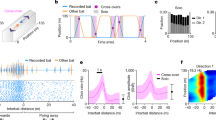Replay and representation dynamics in the hippocampus of freely flying bats
Published in Neuroscience

Explore the Research

Replay and representation dynamics in the hippocampus of freely flying bats - Nature
Nature - Replay and representation dynamics in the hippocampus of freely flying bats
Picture yourself exploring the streets of Venice - as you navigate the sprawling streets and alleys, you take in the sights of the historical buildings, followed by the smell of freshly baked bread, and finally, the taste of a delicious meal. Your brain works tirelessly to integrate these individual experiences into a cohesive, cherished memory. The brain's ability to do so depends crucially on the coordinated activity of large groups of neurons in a brain area called the hippocampus, a fundamental region for memory and navigation. During active navigation, hippocampal neurons called place cells - neurons sensitive to your position - fire in sequence, reflecting the sequence of places you went through. These same sequences are later on reactivated while you are resting - a separate phenomenon called ‘replay’ believed to underlie both planning of the future and consolidation of past experiences into long-term memory. Such emergent phenomena, visible only when one looks at large groups of neurons, have been well characterized in rodents. However, little is known about how these generalize to other mammalian species, including humans. In our paper, we report both the existence as well as surprising differences in these phenomena - neural sequences and replay - in a rather unusual mammal, the Egyptian fruit bat. We selected bats due to their extraordinary natural spatial abilities which offer a unique combination studying the brain under natural conditions while doing so in a highly controlled manner.

Establishing wireless high-density electrophysiology in flying bats
Tackling emergent phenomena of neural ensembles, like replay, requires simultaneously monitoring the activity of large numbers of neurons. In flying bats, this presents a technical challenge because these recordings must be done wirelessly to allow for bats to fly without constraints. Up to now, such recordings have primarily been limited to relatively small numbers of neurons, which has made the investigation of population-level phenomena challenging. In our study, we leveraged high-density silicon electrode arrays called ‘Neuropixels’ to wirelessly record, for the first time, hundreds of neurons simultaneously in a bat. This technical feat allowed us to begin examining the emerging properties of neural ensembles that were not visible when only looking at the activity of a few neurons at a time.
Emergent phenomena of large neural ensembles in bats
In our study, we recorded from the hippocampus of bats’ as they flew freely in a large flight room. The majority of recorded hippocampal neurons increase their firing rates when the bat passes through a specific location in the environment, as expected from classic place cell activity. In other words, these place cells form an internal representation of where in the environment the animal is. Individual place cells have been well characterized in flying bats, but by tracking many place cells simultaneously, we could now reconstruct the bat’s entire flight path beyond the bat’s current location. We found that the same sequences that occurred during flight were reactivated when the bat was resting, but in a time-compressed fashion. This provided the first evidence of time-compressed hippocampal replay in a non-rodent mammalian species. Surprisingly, we found that the length of these replay events remained constant regardless of the duration of the underlying behavior. For example, the place cell sequence that corresponded to a 3 meter flight and the sequence that corresponded to a 20 meter flight would both be time-compressed to a constant duration during replay. We hypothesize that this constant replayed duration may perhaps represent an elemental unit of information processing in the brain. Moreover, we found that the large majority of replays happened when the bat was in a location spatially and temporally remote from the replayed behavior, as opposed to more classic findings in rodents where replay tends to be more local.
Synchronization of internal representations to behavioral oscillations
In addition to examining replay phenomena that occur when the bat is at rest, we also investigated how neural ensembles are coordinated during ongoing movement. In rodents, neural sequences during locomotion are organized in a temporally-compressed fashion through ‘theta sequences’, which sweep ahead of the animal’s current location as a “look ahead” mechanism. Theta sequences are, by definition, believed to depend on theta oscillations, which are prominent ~8 Hz oscillations in the electrical activity across the hippocampus of rodents. However, such continuous theta oscillations are largely absent in other mammalian species including humans and bats. While we similarly observed cyclical sweeps of the internal representation of the bat’s location towards future locations, these sweeps occurred in the absence of any detectable theta oscillations in the bat’s hippocampus. These sweeps were also not related to other forms of non-oscillatory dynamics in the local field potential that have been previously proposed to have a relationship to the firing of hippocampal neurons in bats – a phenomenon that was largely absent in flying bats. Intriguingly, we found that these sweeps were instead locked to the wingbeat cycles of the flying bat, which also occurs at approximately 8 Hz. Wingbeats are not the only 8 Hz behavioral rhythm - from the whisking behaviors in mice to the rhythms of human speech, numerous animal behaviors occur at this frequency. Perhaps there may be something special about the 8 Hz rhythm, both neurally and behaviorally. We hope that our study may shed light on the beginning of a unifying mechanistic understanding of the neural basis of these behaviors in bats and also across the mammalian kingdom.
Follow the Topic
-
Nature

A weekly international journal publishing the finest peer-reviewed research in all fields of science and technology on the basis of its originality, importance, interdisciplinary interest, timeliness, accessibility, elegance and surprising conclusions.
Your space to connect: The Psychedelics Hub
A new Communities’ space to connect, collaborate, and explore research on Psychotherapy, Clinical Psychology, and Neuroscience!
Continue reading announcement



Please sign in or register for FREE
If you are a registered user on Research Communities by Springer Nature, please sign in